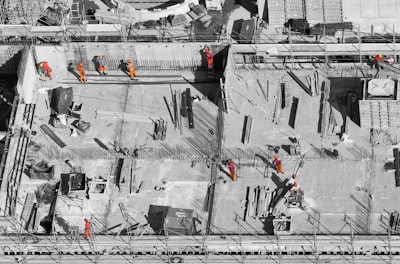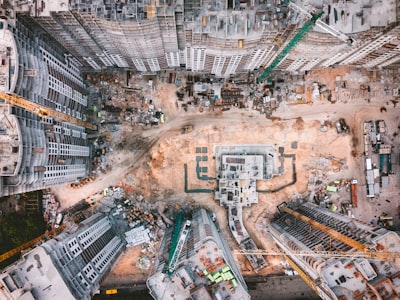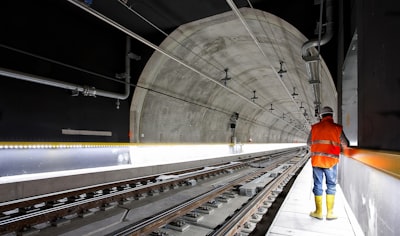Construction Quality Management: Quality is a non-negotiable aspect of any construction project. It’s the cornerstone upon which the safety, durability, and functionality of a structure rest. To uphold these essential qualities, construction professionals rely on two vital practices: Quality Assurance (QA) and Quality Control (QC).
At first glance, these terms might seem interchangeable, but in the intricate world of construction, they represent distinct and complementary approaches. Understanding the differences and synergies between QA and QC is fundamental to delivering successful projects within budget and on schedule while meeting or exceeding the highest quality standards.
In this comprehensive exploration, we will delve into the intricacies of Quality Assurance and Quality Control, revealing their unique roles, objectives, and the collaborative strategies they employ in the dynamic realm of construction projects.
Whether you’re a seasoned construction professional or just embarking on a career in the field, this journey through QA and QC will equip you with the knowledge to ensure that every structure you build stands the test of time. Join us as we navigate the often overlooked, yet critical, world of quality in construction.


What’s the Difference Between QA and QC?
At first glance, the terms Quality Assurance (QA) and Quality Control (QC) may appear similar, even interchangeable, but they play distinct and crucial roles in the successful execution of a construction project. To understand their differences, let’s delve into each concept:
Quality Assurance (QA): QA in construction is akin to a proactive approach. It encompasses the entire set of systematic actions and processes that are implemented throughout a project’s lifecycle to ensure that the end result adheres to pre-established quality standards. QA focuses on preventing defects, mistakes, and deviations from specifications before they occur.
Here are some key aspects of Quality Assurance:
- Standards and Procedures: QA is all about setting and following standardized procedures, guidelines, and quality management systems. These frameworks ensure that the construction project proceeds according to the predetermined criteria.
- Process-Oriented: It’s process-oriented and begins at the project’s planning stage. QA identifies potential issues, risks, and bottlenecks in advance, allowing for corrective actions to be taken early.
- Documented Processes: Documentation is a fundamental aspect of QA. It involves maintaining detailed records and tracking changes, which can be critical for project audits and quality improvement.
- Training and Education: QA necessitates a well-trained team that understands and follows the established procedures and standards. This helps in minimizing errors and enhancing the overall quality of the project.
- Focus on Prevention: The primary goal of QA is to prevent defects and issues from occurring in the first place, rather than detecting and fixing them later in the project.
Quality Control (QC): QC, on the other hand, is a reactive approach. It involves the systematic examination of products, services, or processes to ensure they meet the specified quality standards. QC focuses on identifying defects, deviations, or issues that have already occurred, with the aim of correcting them before they reach the client or end-users.
Here are some key aspects of Quality Control:
- Product-Oriented: QC is product-oriented and is typically implemented during or after the construction process. It involves inspections, testing, and measurements to check if the completed work complies with the quality standards.
- On-Site Inspection: QC often takes place on the job site, where inspectors and quality control officers examine the work in progress. They may use checklists, testing equipment, and visual assessments to detect defects.
- Immediate Corrections: If QC identifies any deviations or defects, it requires immediate corrective actions. This could involve rework, adjustments, or modifications to ensure that the work meets the required standards.
- End-Product Focused: The main objective of QC is to safeguard the quality of the end product. It acts as a final check before the project is handed over to the client.
QA and QC are complementary components of quality management in construction. QA focuses on the prevention of issues by establishing procedures and guidelines, while QC is responsible for identifying and correcting issues during the construction process. By employing both QA and QC, construction professionals can ensure that their projects meet quality standards and are delivered successfully.
Quality Assurance (QA)
QA focuses on the processes and systems used to ensure that the project will meet the desired quality standards. It’s all about prevention and continuous improvement. QA includes the planning, processes, guidelines, and standards set in place before and during the construction phase. It aims to establish quality procedures that prevent defects and reduce the risk of errors. The primary goal of QA is to ensure that the project meets or even exceeds the standards set for it.
QA is a systematic and proactive approach that covers everything from project specifications to the materials used. It involves constant evaluation and assessment of the quality management system to maintain effectiveness.
Quality Control (QC)
QC, on the other hand, deals with the end product. It’s the process of inspecting the actual construction work to ensure that it aligns with the specified quality standards. QC is a reactive approach that focuses on identifying and correcting defects in the final product. It includes the physical inspections, tests, and checks carried out during and after construction is complete.
QC ensures that the work as it occurs is free from defects and meets the predefined quality requirements. It often involves on-site inspections, checking the workmanship, and using corrective action to help ensure that the end product is of high quality.
QA in Construction
Quality Assurance is an essential element of any construction project. It involves various aspects and practices that help maintain and improve the quality of work throughout the construction process. Here’s what you need to know about QA in construction:
Quality Management
Quality Assurance (QA) is an encompassing approach in construction management that involves a set of practices, standards, and techniques aimed at ensuring that a construction project consistently meets or exceeds predetermined quality standards. In essence, QA is all about maintaining quality throughout the project’s lifecycle and creating an environment where quality is not just a goal but a fundamental aspect of every activity.
Here’s a breakdown of the components within the realm of QA:
- Quality Management Standards: QA starts with the establishment of quality standards. These standards define the criteria that the project must adhere to. They encompass not only the final product but also the processes, materials, and workmanship required for the project.
- Quality Management Software: Technology plays an increasingly vital role in QA. Quality management software is utilized to record, track, and manage quality-related data and processes. It enables project managers to monitor progress, track changes, and analyze data to identify trends or areas that require attention.
- Creating a Quality-Focused Work Environment: QA fosters a work environment where every team member, from engineers to contractors, is acutely aware of the importance of quality. It instills a culture where every individual is committed to delivering high-quality work, and there is a collective effort to minimize defects and errors.
- Quality Management System: The quality management system (QMS) is at the heart of QA. It involves a structured and systematic approach to quality management. A QMS sets out processes and procedures for each phase of the project. This ensures that all activities are planned, controlled, and monitored. A well-implemented QMS helps in standardizing processes and reducing variations.
- Planned and Systematic Activities: QA requires that all activities are planned and carried out systematically. It means there is a pre-defined process for each aspect of the construction project. This planning minimizes ad-hoc decision-making and reduces the likelihood of defects.
- Meeting or Exceeding Quality Standards: The ultimate goal of QA is to meet or exceed established quality standards. It goes beyond merely checking off boxes to ensure compliance. QA strives to deliver a final product that not only satisfies but often surpasses the client’s expectations, leading to higher customer satisfaction and a stronger reputation in the industry.
QA in construction is a comprehensive approach that entails more than just inspections and checklists. It’s about setting high-quality standards, employing advanced software and technologies, and fostering a culture of quality within the project team. The establishment of a quality management system ensures that all processes are well-structured and systematic, ultimately working towards the consistent delivery of top-notch construction projects.
Prevention of Rework
One of the fundamental objectives of Quality Assurance (QA) in construction is to proactively prevent the need for rework. Rework, which involves redoing tasks or correcting errors, can have a cascading impact on construction projects, leading to substantial delays, escalated costs, and overall inefficiency. QA procedures are meticulously designed to mitigate rework by ensuring that quality standards are met from the outset and maintained throughout the project’s lifecycle.
Ensuring Quality Materials
Materials and construction materials are a significant factor in construction quality. QA procedures ensure that the materials used meet the necessary quality standards and that their usage complies with guidelines and recommendations.
Risk Reduction
QA in construction aims to reduce the risk of errors and defects. By establishing planned and systematic activities, quality standards, and quality procedures, construction projects can minimize the risk of costly mistakes or delays.
High-Quality Results
Ultimately, the goal of QA is to deliver high-quality results. It is a structured approach to construction that helps ensure the end product is free from defects, adheres to quality requirements, and satisfies all standards set for the project.
QC in Construction (Construction qc)
Quality Control, while different from QA, is equally vital in construction. It involves physical inspections and checks on the actual construction work to identify and rectify any defects. Let’s explore the key aspects of QC in construction:
Inspection and Testing
QC in construction primarily involves inspection and testing. It requires dedicated personnel to conduct inspections and tests during and after the construction process. These inspections ensure that the work as it occurs is free from defects and adheres to the defined quality requirements.
On-Site Quality Work
Quality Control often takes place on the job site. This means that quality control officers or teams are responsible for checking the workmanship, ensuring that the project meets the required standards, and taking corrective action when necessary.
Final Product Inspection
One of the critical roles of QC is to inspect the final product. This involves a meticulous examination of the project to verify that it’s free from defects and aligns with quality requirements and specifications.
Meeting Set Standards
QC inspections ensure that the project meets the standards set for it. This includes complying with building codes, adhering to project specifications, and aligning with all quality requirements.
QA vs. QC – The Collaboration (quality control and quality assurance)
In construction, QA and QC should not be seen as competing processes. They are, in fact, complementary. QA ensures that the right processes and guidelines are in place to prevent defects, while QC verifies that the final product adheres to these guidelines. Both are essential for ensuring that a construction project is successful.
The relationship between QA and QC is like a well-choreographed dance. QA sets the stage by defining the steps and standards, while QC performs the checks to ensure that the dance is executed flawlessly. When QA and QC work together seamlessly, the end result is a construction project that meets or exceeds quality standards.
Best Practices for QA and QC in Construction
To ensure the success of your construction project, it’s essential to incorporate best practices for both Quality Assurance and Quality Control:
1. Establish a Comprehensive Quality Program
Develop a comprehensive quality program that encompasses both QA and QC aspects. This program should define quality standards, guidelines, procedures, and methodologies for the entire project.
2. Customer Satisfaction
Remember that the end goal is customer satisfaction. Quality Assurance and Quality Control play a significant role in achieving this by delivering a high-quality final product that meets or exceeds customer expectations.
3. Effective Communication
Effective communication between the QA and QC teams is vital. They should work collaboratively to ensure that the project’s quality requirements are consistently met.
4. Learn the Difference
Ensure that all project stakeholders, including project managers and construction teams, understand the difference between QA and QC. This knowledge will help streamline the processes and improve project outcomes.
5. Ongoing Training
Invest in ongoing training and development for quality assurance and quality control officers. Staying updated on the latest techniques and activities can help improve the quality of construction projects.


Project Management (Construction Quality Management)
Construction Quality Management/Project Management is a crucial discipline in the field of construction, as well as in various other industries. It involves the planning, organization, coordination, and control of resources and activities to achieve specific project objectives. In construction, project management plays a pivotal role in ensuring that a project is executed successfully, on time, within budget, and to the satisfaction of all stakeholders. Here’s a comprehensive look at the concept of project management in the context of the construction industry:
- Project Initiation: This is the phase where the project’s feasibility and overall scope are assessed. It involves defining the project’s objectives, budget, and timeline, as well as identifying key stakeholders and potential risks. In construction, this stage might involve site selection, obtaining permits, and developing a project charter.
- Project Planning: In this phase, a detailed project plan is developed, including schedules, budgets, and resource allocation. Construction project planning encompasses creating a project schedule, identifying required materials and labor, and establishing quality and safety standards.
- Project Execution: This is the phase where the actual work takes place. It involves coordinating resources, assigning tasks, and ensuring that the project is carried out according to the plan. In construction, this phase encompasses tasks such as site preparation, construction, and inspections.
- Project Monitoring and Control: Throughout the project’s lifecycle, it’s crucial to monitor progress, quality, and costs. This involves comparing the project’s actual performance against the plan, making necessary adjustments, and addressing issues as they arise. In construction, this phase involves regular site inspections, quality control, and safety monitoring.
- Risk Management: Construction projects often face a variety of risks, such as weather-related delays, supply chain disruptions, or unforeseen site conditions. Project management includes identifying potential risks, developing strategies to mitigate them, and having contingency plans in place.
- Quality Management: Ensuring the quality of construction work is paramount. Project managers set quality standards, establish inspection procedures, and monitor the work to meet those standards. Quality management helps prevent defects and rework, which can lead to cost overruns and delays.
- Resource Management: Project managers are responsible for allocating and managing resources effectively. In construction, this includes managing labor, equipment, and materials to ensure that they are used efficiently and according to the project plan.
- Communication: Effective communication is essential in construction project management. Project managers facilitate communication between team members, stakeholders, and contractors. Clear communication helps prevent misunderstandings and ensures that everyone is aligned with the project’s objectives.
- Closure and Handover: Once construction is complete, there is a process of project closure and handover. This involves ensuring that all project deliverables are met, final inspections are conducted, and the project is handed over to the client or end-users.
- Documentation: Accurate and organized documentation is essential in construction project management. This includes maintaining records of contracts, change orders, progress reports, safety records, and other project-related documents.
Project management is a dynamic and multifaceted discipline, and it plays a critical role in ensuring that construction projects are executed efficiently, on time, and to the desired quality standards. It helps manage the complexity of construction projects, aligns all stakeholders, and ultimately delivers successful outcomes.
Construction Quality (Quality in Construction)
Construction Quality refers to the degree of excellence, standards, and performance of a construction project or the materials, workmanship, and processes involved in the construction. It is a fundamental aspect of any construction project and encompasses a range of factors that determine the overall durability, safety, functionality, and aesthetics of the final structure. Understanding construction quality is essential for delivering a successful and sustainable construction project.
Construction quality is a multidimensional concept that involves many stakeholders, including architects, engineers, contractors, project managers, and quality control teams. Achieving high construction quality requires effective collaboration, adherence to industry standards, and a commitment to excellence throughout the project’s lifecycle. High-quality construction results in buildings and infrastructure that are not only safe and functional but also durable, aesthetically pleasing, and economically sustainable.
Improve qa vs quality.
“Improve QA vs Quality” refers to the distinction between two related concepts in the construction industry: “improving quality assurance (QA)” and simply achieving “high-quality” results. Here’s a brief explanation of the difference:
- Improve QA: This focuses on enhancing the processes and methods related to quality assurance. It involves continually refining and optimizing the procedures, standards, and strategies used to prevent defects, errors, and issues throughout a construction project. Improving QA aims to make quality assurance more effective, efficient, and comprehensive, reducing the need for corrective actions and rework. It involves ongoing evaluation and enhancement of quality control and quality management processes.
- Quality (High-Quality Results): Quality, in the context of construction, refers to the ultimate outcome or product’s characteristics. Achieving high-quality results means that the constructed building or infrastructure meets or exceeds the specified quality standards, is durable, safe, and functions as intended. It is the end goal of a construction project, ensuring that the final product satisfies the client’s requirements and expectations.
“Improving QA” concentrates on the methods and systems used to ensure quality, while “quality” focuses on the actual standard of the completed construction project. By continually refining QA processes, construction projects can enhance the likelihood of delivering a high-quality final product while minimizing defects and rework.
Conclusion
Quality Assurance (QA) and Quality Control (QC) are two pillars of construction quality management. They may be distinct, but they go hand-in-hand to ensure that a construction project is completed successfully and meets all quality standards.
The collaboration between QA and QC in construction is crucial for delivering projects that meet or exceed quality requirements, satisfy customers, and avoid costly defects and rework. By understanding the difference and implementing best practices, construction professionals can strive for excellence in every project they undertake.
In summary, QA focuses on the processes and systems that prevent defects, while QC deals with the inspection and testing of the final product to ensure it adheres to quality standards. Working together, QA and QC contribute to the success of construction projects.
Sameera Building Construction
Your One-Stop Shop for Building Dreams (Literally!)
We've got bricks, we've got beams, and we've got a bunch of hard hats.
Because when it comes to construction, we don't just build buildings; we build stories.
Visit Us Now and Join the Fun!Source link
